#keraites
Text
Genghis Khan's life is told in the (sometimes fantastical) Secret History of the Mongols parts of which likely date to the first half of the 13th century as well as later Chinese and Arab sources. He was born to aristocratic parents and was given the birth name of Temujin (Temuchin), named after a Tartar (Tatar) captive. The date of birth is not known for certain with some scholars choosing 1162 and others 1167. Legend has it that the infant was born clutching a clot of blood in his right hand, an ominous omen of things to come. Temujin's mother was called Hoelun and his father, Yisugei, who was a tribal leader, and he arranged for his son to marry Borte (aka Bortei), the daughter of another influential Mongol leader, Dei-secen, but before this plan could come to fruition, Temujin's father was poisoned by a rival. Temujin was still only nine or twelve years old at the time and so he could not maintain the loyalty of his father's followers. As a consequence, he and his mother were abandoned on the Asian steppe, left to die. However, the outcast family managed to forage and live off the land as best they could.
Things then got even worse when the young Temujin was captured by a rival clan leader, perhaps following an incident where Temujin may have killed one of his older half-brothers, Bekter, who likely represented a rival branch of the family that had taken on the legacy of Yisugei. Fortunately, Temujin was able to escape during the night and, gathering around him the few still-loyal followers of his father, he joined up with Toghril, chief of the Kerait, a tribe that his father had once helped. Temujin then married his betrothed from several years earlier, Borte.
Before long the leadership and martial talents of Temujin brought him victories over local rivals and his army grew in size. The conflicts were bitter with one tribal leader infamously boiling his captives in 70 large cauldrons. Temujin proved unstoppable, though, and he managed to unify most of the different nomadic tribes which roamed the grasslands of central Asia, each one composed of different but related clans, by creating a web of alliances between them. Temujin made himself the dominant leader through a mix of diplomacy, generosity, and his own ruthless use of force and punishments. Defeated tribes were sometimes compelled to join his army or killed to a man. Courageous himself in battle, Temujin would often reward bravery shown by the defeated, famously making a man called Jebe one of his generals because he had withstood a cavalry charge and fired an arrow that felled Temujin's own horse.
#studyblr#history#military history#warfare#mongol empire#keraites#mongolia#genghis khan#hoelun#yesugei#börte#toghrul#jebe
0 notes
Photo
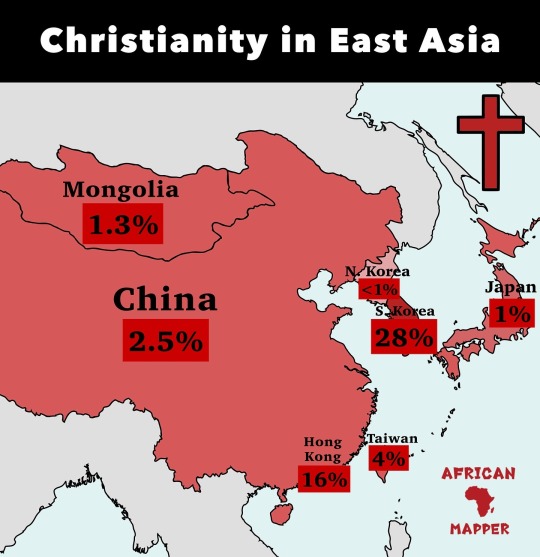
Christianity in East Asia
Christianity may have existed earlier in China, but the first documented introduction was during the Tang dynasty (618–907) A Christian mission under the leadership of the priest Alopen was known to have arrived in 635, where he and his followers received an Imperial Edict allowing for the establishment of a church. In China, the religion was known as the Luminous Religion of the Romans. Mongols had been proselytized by Nestorian Christians since about the 7th century, and several Mongol tribes, such as the Kerait, Naimans, Merkit, and to a large extent the Kara Khitan (who practiced it side by side with Buddhism), were also Christian.
by african.mapper
133 notes
·
View notes
Text
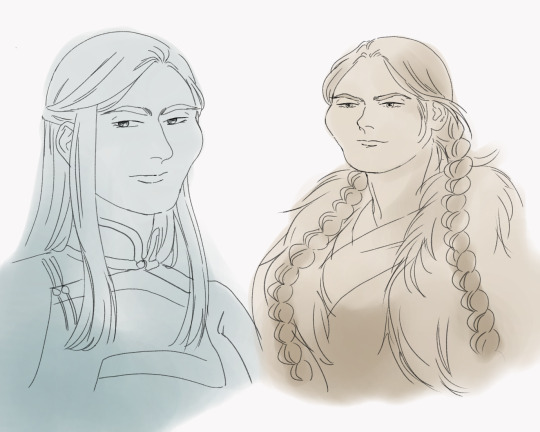

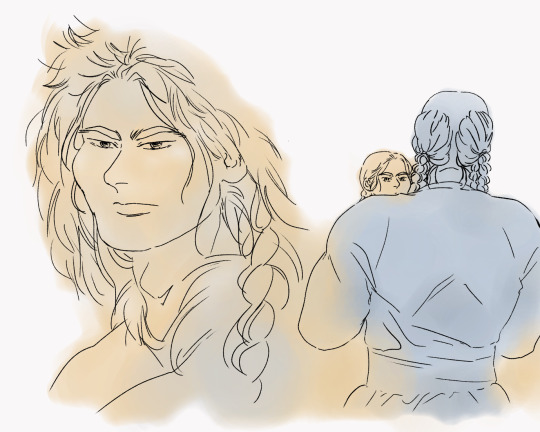
1) Buryatia + nyo!Mongolia
2) Kyrgyzstan + Mongolia and (Yenisei) Kyrgyz
After its establishment, Mongol Empire quickly subjugated Turkic confederations and groups in the territory of Mongolia and around the Baikal such as Kerait, Naiman, Merkit, Tatar, and Yenisei Kyrgyz (though Merkit was probably Mongolic). All these Turkics were Mongolia’s first harem. In the end, only the Kyrgyz would survive as distinct people into the current time as most of them became modern Kyrgyz people in Kyrgyzstan. The others were quickly absorbed into Mongolians or Kazakh.
It’s unknown whether Kyrgyzstan is the former Yenisei Kyrgyz or if he is a successor who carries the latter’s memories, but Mongolia feels familiar with Kyrgyzstan beyond what he would feel about a country who happens to share a similar nomadic culture. As it stands, today’s Kyrgyzstan looks different from the mostly West Eurasian Yenisei Kyrgyz, but Mongolia almost swears they’re the same person. Mongolia could also differentiate easily between Kazakhstan and Kyrgyzstan even when many others aren’t able to (“How are you not able to distinguish them? They’re massively different!” Says Mongolia)
(I gave Yenisei Kyrgyz Göktürk era clothing as I haven’t found their specific costume, lol)
3) Golden Horde + baby Golden Horde carried by Mongolia
When Golden Horde was newly born, he was close to Mongolia who would often carry him everywhere (or let his horse do the job). Think of a toddler who stares unblinkingly at you from underneath all the fur wrapped around his tiny body as if trying to drill a hole into the area between your eyes. Meanwhile, Mongolia would smile proudly at him.
#hetalia#aph mongolia#oc golden horde#oc kyrgyzstan#oc buryatia#hws mongolia#hws golden horde#hws kyrgyzstan#hws buryatia#my art#my headcanon
11 notes
·
View notes
Text
“...Where the show had sensibly added yurts and merely forgot to have any way to move them, Martin has the Dothraki live in “palaces of woven grass” (AGoT, 83) which I assume the show did not replicate because the moment someone described doing that everyone realized what a bad idea it was and moved on to something more sensible like a yurt covered in leather. Grass and reeds, of course, can be woven. However, as anyone who has done so will tell you, the idea of trying to weave what is essentially a grass basket the size of a tent in a single day is not an enviable – or remotely possible – task.
Trying to move such a giant grass basket without it coming apart or developing tears and gaps is hardly better. And at the end, a woven-grass structure wouldn’t even really be particularly good at controlling temperature, which is its entire purpose! It is rather ironic, given that unlike the show’s Dothraki, Martin’s Dothraki do seem to use at least some carts, because Viserys is forced to ride in one (AGoT, 323) and so could bring yurts with them. They just don’t.
More to the point, it is very clear that Martin imagines the Dothraki subsistence system to consist almost entirely of horses. The Dothraki ride horses, they eat horses, they drink fermented mare’s milk. The Dothraki – as in the show – are presented as eating almost entirely horsemeat. They eat horsemeat at the wedding (AGoT, 84), and Daenerys’ attendants are surprised that she asks for any kind of meat other than horse (AGoT, 129), although Daenerys herself seems to have access to a more agrarian diet (AGoT, 198) and other characters observe that the Dothraki prefer horsemeat to anything else (AGoT, 272). There is no mention of herds of anything except people and horses moving with the khalasaar.
There is also no sense that the Dothraki are hunting big game like one would in the Great Plains; Drogo kills a hrakkar – a sort of lion, apparently – as a display of bravery (AGoT, 495) but there is nothing that would suggest the kind of bison-based subsistence system (at the very least, if that was the system, Daenerys would be well aware of it, because the camp would be awash in bison-products). I found no references to larger game and the Wiki only offers, “packs of wild dogs, herds of free-ranging horses, and rare hrakkar” which is, needless to say, not enough to make up for the absence of large herds of bison, especially for trying to feed Drogo’s camp of perhaps a hundred thousand people (or more!).
They clearly do not herd sheep. This becomes painfully obvious with the raid on the Lhazareen village. The Dothraki – Khal Ogo’s men – in raiding a sedentary pastoralist settlement, kill all of the sheep and leave them to rot. Dany sees them “thousands of them, black with flies, arrow shafts bristling from each carcass” and only knows that this isn’t Drogo’s work because he would have killed the shepherds first (AGoT, 555). And we are told that the people there “the Dothraki called them haesh rakhi, the Lamb Men….Khal Drogo said they belong south of the river bend. The grass of the Dothraki sea was not meant for sheep” (AGoT, 556).
We are told that the Dothraki have “vast herds” but this can only mean herds of horses, given that they apparently take offense at any other animal being grazed on the Dothraki and look down at shepherds in general (AGoT, 83). To be clear, for a nomadic people moving over vast grassland to spurn the opportunity to capture vast herds of sheep would be extraordinarily stupid. At the very least, thousands of sheep are valuable trade goods that can literally walk themselves to the point of sale (we’ll get to this idea that the Dothraki also don’t understand commerce a little later, but it is also intense rubbish; horse nomads in both the New World and the Old understood trade networks quite well and utilized them adroitly). But more broadly, as I hope we’ve laid out, sheep are extremely valuable for subsistence in Steppe terrain.
But Martin does not even do horse-string logistics right. While Daenerys eats cheese (AGoT, 198), we never hear of the Dothraki doing so. The Dothraki do have an equivalent to qumis, but no qulut, no yogurt. Even the frankly badass bit about drinking the horse’s blood as a source of nourishment does not appear. The horses themselves are also wrong. First, Daenerys and Drogo each have one horse they use, seemingly to the exclusion of all others. If you have been reading this long, you know that is nonsense: they ought to both (and Jorah too, if he intends to keep up) be shifting between multiple horses to avoid riding any of them into the ground. Moreover, Martin has imported a European custom about horses – that men ride stallions and women ride mares – into a context where it makes no sense. Drogo’s horse is clearly noted as a red stallion (AGoT, 88) while Daenerys’ horse is a silver filly (AGoT, 87). But of course the logistics of Steppe raiding revolves around mares; in trying to give Drogo the ultimate manly-man horse, he has actually given him the equivalent of a broken down beater – a horse only able to fulfill a slim parts of its role.
Finally, the group size here is wildly off. For comparison, Timothy May estimates that, in 1206, when Temujin he took the name Chinggis Khan and thus became the Great Khan, ruling the entire eastern half of the Eurasian Steppe, that the Mongol army “probably numbered less than a hundred thousand men” (May, The Mongols, (2019), 43), though by that point his army included not merely Mongols, but other ethnically distinct groups of steppe nomads, Merkits, Naimans, Keraites, Uyghurs and the Tatars (the last of which Chinggis had essentially exterminated – next time, we’ll get to the nonsense of the Dothraki being a single ethnic group).
That is, to be clear, compared to the armies of sedentary empires of similar size (which is to say, huge) a fairly small number! We’re going to come back to this next week, but the strength of Steppe nomads was never in numbers. Pastoralism is a low density subsistence strategy, so the steppe nomads were almost always outnumbered by their sedentary opponents (Chinggis himself overcomes this problem by folding sedentary armies into his own, giving him agrarian numbers, backed by the fearsome fighting skills of his steppe nomads).
Khal Drogo’s khalasaar, which moves as a single unit, supposedly has 40,000 riders (AGoT, 325-6); Drogo is perhaps the strongest Khal, but still only one of many. With 40,000 riders, we have to imagine an entire khalasaar of at least 120,000 Dothraki (plus all the slaves they seem to have – put a pin in that for later; also that number is a low-ball because violent mortality is clearly very high among the Dothraki, which would increase the proportion of women and children) and probably something like 300,000 horses. At least. Of course no grassland could support those numbers without herds of sheep or other cattle. As noted above, Isenberg’s figures suggest much lower density in the absence of herding – just under 70,000 nomadic Native Americans on the Great Plains in 1780 (and less than 40,000 in 1877), including women and children! But more to the point, no assemblage of animals and people that large could stay together for any length of time without depleting the grass stocks.
Even if we ignore that problem and even if we assume that the Dothraki have Mongol-style pastoral logistics to enable higher population density on the Dothraki Sea, my sense is that the numbers still don’t work. Even before Drogo dies, we meet quite a few other independent Khals with their on khalasaars – Moro, Jommo, Ogo, Zekko and Motho at least and it is implied that there are more. Drogo’s numbers suggests he should be roughly at the stage Chinggis Khan was in 1201 or so – with Chinggis controlling roughly half of the Mongolian Steppe, and his old friend and rival Jamukha the other half. But Khal Drogo has evidently at least a half-dozen rivals, probably more. It is hard to say with any certainty, but the numbers generally seem too high. Having that entire group concentrated, moving together for at least nine months (long enough for Daenerys to become pregnant and give birth) would be simply impossible inside of a grazing-based subsistence system, sheep or no sheep.
In short, no part of this subsistence system works, either from a North American or a Eurasian perspective. This isn’t actually much of a surprise. Martin has been pretty clear that he doesn’t like the kind of history we’re doing here. As he states: I am not looking for academic tomes about changing patterns of land use, but anecdotal history rich in details of battles, betrayals, love affairs, murders, and similar juicy stuff.
That’s an odd position for an author who critiques other authors for being insufficiently clear about their characters’ tax policy (what does he think they are taxing, other than agricultural land use?). Now, I won’t begrudge anyone their pleasure reading, whatever it may be. But what I hope the proceeding analysis has already made clear is that it simply isn’t possible to say any fictional culture is ‘an amalgam’ of a historical culture if you haven’t even bothered to understand how that culture functions. And it should also be very clear at this point that George R. R. Martin does not have a firm grasp on how any of these cultures function.”
- Bret Devereaux, “That Dothraki Horde, Part II: Subsistence on the Hoof.”
72 notes
·
View notes
Note
I can read and don't understand how you can argue Xaela are anything but Mongolian. Also that's some broken Mongolian, good job on the google translate!
ok well i didn’t say they were i meant like there are other cultures that fall under the same umbrella ya fucking dumb ass. i am literally a tatar and have family married into other cultures under the same umbrella.
literally the mongolian empire wasn’t just mongolians it was many tribes absorbed to create the empire, such as the keraites, khamag mongol, naiman, mergid, and THE TATAR. WHAT I AM.
because of this turkic cultures are very similar, i can understand words in uyghur, kazak and altay. mongolian too. in game there are some things that are added that even i dont think the dev team understands is leaning more towards a certain group or tribe. literally if i went to visit another village that was perhaps uyghur we’d be doing the same shit with different details.
like please don’t try and think you know it all because you >THINK
also i was speaking tatar but sure go ahead with “broken mongolian” despite modern day mongolian is actually written in cyrillic script????????????????????????????????? what are you on
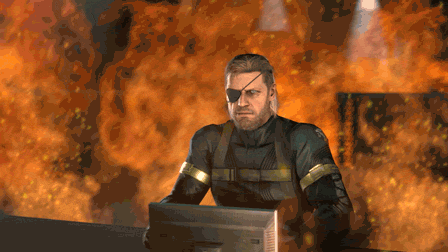
22 notes
·
View notes
Photo
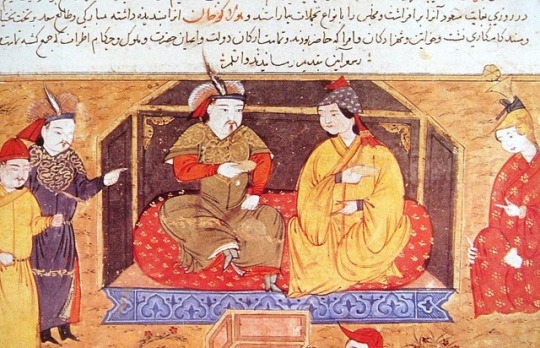
Hulagu Khan, grandson of Genghis Khan and founder of the Ilkhanate, seated with his Eastern Christian queen Doquz Khatun of the Keraites (at Fontana, California)
1 note
·
View note
Photo

The escutcheon I designed for The Keraite Dynasty, the ruling clan of the most powerful tribal confederation in Sibirsk, a fringe territory of The Tsardom of Rus’skaya. Artwork for a low-fantasy setting of my design with technology equivalent to the late medieval and renaissance periods, where formations of heavily armoured and mounted knights fight alongside armies of pikemen and matchlock musketeers, where medieval-style stone castles are gradually being outsourced in favour of both lavish country estates and devoted military fortifications due to the advancements made in artillery technology, and where rising nation-states in the form of Kingdoms and Empires look beyond the boundaries of the known world in search of greater wealth and territory. In context to the lore of my fantasy setting, The Keraite Dynasty is the ruling clan of the most powerful tribal confederation in Sibirsk and tributary subjects to House Vojvodin of The Tsardom of Rus’skaya, with a culture resembling northern and central Asian steppe nomads. The colour scheme of this escutcheon was loosely inspired by those of the White Scars Space Marine Legion and Chapter from Warhammer 40k.
#coats of arms#heraldry#shields#medieval#renaissance#chivalry#fantasy#fantasy world#graphic design#art#Temur Khagan
10 notes
·
View notes
Photo

793 yıl önce bugün kaybettiğimiz Büyük hükümdar Cengiz Hanı tekrar anmak istedim. 1162’de Moğolistan’da doğdu. 1183’te Kerait Hükümdarı Tuğrul Han’ın emrine girdi. 1204’de Chakirmaut Savaşı’nda Naymanlar’ı yendi. 1206’da Cengiz unvanıyla hakan ilan edildi. 1220’de Buhara’yı ele geçirdi. 1227’de Kuzeybatı Çin’de öldü. Moğol dilinde asker kelimesinin karşılığı yoktur. Çünkü tüm Moğol toplumu çatışma esasına göre kurulmuştur. Kabilenin her üyesi savaşta bir görev üstlenir ve seferberlik sırasında devasa bir mekanizmanın dişlileri gibi uyumlu bir şekilde hareket ederlerdi. Komutanlar tüm askerlerin hazırlığından sorumlu tutulur ve gerekirse gece gündüz askerlerini kontrol eder ve savaşta kullanılacak iğne ve ipliğe kadar tüm malzemelerinin tamam olmasını sağlarlardı. Ordularında ordu askerlere maaş vermez, tam aksine askerler üstlerine yağmadan pay verirdi. https://www.instagram.com/p/CEBjlbYplzj/?igshid=bh1h9y5fqwvq
0 notes
Photo
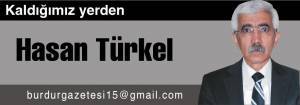
Burdur Turizm’de niye sınıfta kalıyor?: Teke Yöresi’nin dolayısı ile Teke Kültürü’nün Başkenti Burdur, aynı zamanda, Sagalassos, Kibrya, Kremna Antik Kentleri, Hacılar Höyüğü’nde ortaya çıkarılan kalıntılar, Kuruçay Höyüğü’nde ortaya koyulanlar, Boubon, Milas, Sia, Balboura antik Kentleri, Lisinia, Olbasa, Keraitate, Kodrula Antik Yerleşim yerleri, Susuz Han, İncir Han, Saat Kulesi, Derviş... https://goo.gl/2gyvgy
0 notes
Text
This is a summary of an article written by Peter B. Golden in 2000 (plus my own notes) on Mongol conquest of Turkic peoples. The Turkic people have migrated and settled in many places throughout Asia away from their historical homeland around Altai mountains and Western Mongolia even before the rise of Mongols, but the Mongol conquest produced the last in a series of realignment of Turks into a shape that we know of today. Definitely, as we’ve known, this construction wasn’t only about further migration of Turks (whether they fled the Mongols or relocated under Mongol command) but also about a lot of intermixing between the two that produced Turko-Mongols which these days are typically known as just Turkics.
Alternatively, this list is called 'Mongolia's Turkic harem' lol. He really travelled all the way from his homeland to the far west to capture all the Turkics and add them into his fold. I don't know if he managed to get absolutely ALL of them, like, did he?? But even if he didn't, the list still stretches long so he really did an astounding job.
The explanations in this list might not be fully correct but I tried my best!!
So, starting from the first Turkic people to submit or come into contact, they were:
The Keraites, in 1203. It’s unclear whether they were actually Mongolic or Turkic, or maybe a mix as they had formed a lot of coalitions with the Mongols even before the rise of Mongol Empire. Toghrul Khan of the Keraites was a bloodbrother or anda to Yesugei, Chinggis Khan’s father. Sometimes they would be in conflicts with Chinggis Khan’s party, but in general the Keraites were allies.
The Önggüd, in 1204. They were descended from the Sarts who in turn were descended from the remnant tribes of Western Turkic Khaganate. Many of them were Nestorian Christians and later they would become Mongolized.
The Naiman, in 1204. Again it’s unclear whether they were Mongolic or Turkic, with some saying they could be Mongolized Turks or even Turkic speaking. The Naiman Khanate tho was located around Western Mongolia so I think they were significantly Turkic leaning. This group would prove quite a pain to the Mongols as one of its member, Küchlüg, ran to Qara-Khitai realm in order to flee them and married a royal princess. He would then usurp the Khitan throne and was later defeated by Mongol general Jebe. The Naiman would later be absorbed into Mongol and other newer Turkic groups like Kazakh.
The Yenisei Kyrgyz, in 1207-8, along with other forest and forest-steppe peoples such as the Altay Turks. The Yenisei Kyrgyz dwelled along the Yenisei river in Siberia, with the core of their homeland in the mountainous area of what is now Tuva. The Yenisei Kyrgyz would be subjected to displacements that ultimately brought some of them into the confines of Moghulistan where the final ethnogenesis of modern Kyrgyz of Kyrgyzstan took place, involving other Turkics and Mongols. Today the Kyrgyz speak a Qipchaq branch of Turkic language. Must be noted that there are other groups that descended from Yenisei Kyrgyz such as Khakas people in Khakassia and Altai people in Altai Republic (both in Russia).
The Qocho Uyghurs as initiated by Barcuq who submitted in 1209 and was accepted as “the fifth son of Chinggis Khan”, with a Chinggisid bride being married to him sealing the ties. Qocho Uyghur was a state founded by Uyghur refugees who fled the destruction of Uyghur Khaganate after being driven out by the Yenisei Kyrgyz. The Uyghurs were favored a lot and due to their capabilities rose to prominence under Mongol Empire and served in far-flung territories under Mongol dominion like Yuan and Ilkhanate. In time, the Qocho territory would pass into the house of Chagatai.
Qarluq Turks, in 1211, who were one of the primary constituent elements of Qarakhanid state in Central Asia. Some of the prominent figures in this group were even given Chinggisid brides which showed that Chinggis Khan was adamant in binding the important Turkics to him. The Yuan-Shi, or Yuan era historical work, records Kublai explaining to a Korean ruler and his son that the Uyghurs and Qarluqs held the first rank among the subject kings because they had submitted first. Anyway, the Qarluqs, who were once also part of Göktürk Khaganate, had links to the Uzbeks and modern Uyghurs with the two speaking Qarluq branch of Turkic languages.
Qipchaqs/Polovtsy, and the Qangly who are purpoted to be related to the Qipchaqs, were particularly problematic toward the Mongols. The Qangly had contacts with the Keraites and Naimans who were foes with Chinggis Khan and that's probably why they were targeted. The Qipchaqs also granted refuge to Merkid princes in 1217-19 or earlier (we all know the Merkids were as good as archenemies with Chinggis Khan) and it was said that this event brought about the first military encounter between the Mongols and Qipchaqs. The Qipchaqs also allied with the Rus against the Mongols in the famous Battle of Kalka River in 1223 which ultimately brought the Mongols into the heart of Russian realm and the territory of Cuman-Qipchaq confederation after their defeat. Afterward, the Qipchaqs would be entered into Jochid ranks in Golden Horde or elsewhere the Mongols wanted them, with the others butchered or fleeing as far as possible either as slave soldiers, local aristocracy (in Rumania and Moldavia) or even as important component of the Second Bulgarian Empire. The Qipchaqs finally perished as a group by 1241-2 but would survive as components of the Baskirs, Uzbeks, Turkmen, Karakalpaks, Kazakhs, Kyrgyz, Altai, Nogays, and Crimean Tatars.
Khwarazmia which comprised large parts of today's Iran, Central Asia, and Afghanistan. It was a Persianate state of Turkic mamluk origin, with mamluk being a term that denoted non-Arab slave soldiers and freed slaves who were assigned military and administrative duties. Mamluk states were born from slaves who climbed ranks, which meant they weren't originally of nobility. Anyway, Mongol enmity with the Khwarazmians that peaked in 1219 with an invasion started when the latter killed a Mongol-sponsored caravan of Mongol-sponsored Central Asian Muslim merchants who also happened to be intel. Anyway, killing or mistreating Mongol ambassadors or envoys is basically a no-no and this gives the Mongols a permission, as per nomadic rules, to ravage the culprits along with their collective group.
Volga Bulgars, who were finally defeated in 1236. They were a Muslim group who spoke an Oghuric branch of Turkic language. In time, Volga Bulgaria would be included into Kazan Khanate, being one of the successor states of Golden Horde.
Seljuks of Anatolia/Rum who were defeated at Köse Dağ in 1243 and became tribute paying vassals to the Mongols. In time, they would pass into the Ilkhanid dominion and kept at chokehold until its eventual disintegration. Rum itself had started to weaken even before the Mongols took it in, and along with its and Ilkhanate's dissolution numerous Anatolian beyliks (statelets) would take shape with Ottoman Empire ultimately rising from one of them.
2 notes
·
View notes
Text

Mongolia vs Türks showing who’s in charge of the lands now*
(Khun Chuluu is a stone monument in the shape of a man, I think usually for memorials. There are many stone monuments erected by the Turkics bc they were the masters of the land for centuries before Mongolia rose to power)
*Certainly, in the medieval-before Mongol empire era not everyone is classified under Türks. This term was once reserved for the Göktürks and other Turkic speaking ppls like Uyghurs, Kyrgyz, Kerait and Naiman were once regarded as their own name without an umbrella name of Turkic. This umbrella grouping is a newer phenomenon (which doesn’t make it less valid as now ppl have their own needs (and agendas) for grouping the Turkic speakers together).
3 notes
·
View notes
Text
Depending on how old you have Turkey, he’d actually have met Ilkhanate and potentially even Mongolia (Empire). I’m not firm on his age yet, but discord chat talks about him existing since Seljuk which is actually older than Mongol Empire itself (ofc, Mongolia himself might be older than Mongol Empire and I indeed put him older, it’s just no one really knows his actual age) and in that case, as Sultanate of Rum he would’ve been a vassal to Ilkhanate. Imagine how pissed Turkey was!!
But the book I read also theorizes that it was the nomads Mongol Empire primarily wanted to subjugate, not the sedentary people. In that case, Russia, China, Persia were collateral (?) and a byproduct of secondary expansion. Not that they weren’t important because they formed a bulk of critical things like trade, but yeah. Tbh, I think this has some bearings as Mongol Empire roughly followed Göktürk expansion and the nomads were the first peoples the Mongols subjugated, it’s that if the sedentary people murdered Mongol ambassadors the Mongols would brand them as enemies to subjugate (they did try to provoke the sedentary people into mistreating their ambassadors so they had ample reason to come whack them, lol). Possibly, it also had to do with Chinggis Khan’s descendants’ own ambition?? They kept expanding because they also competed with the other descendants for influence, and if the other descendants took some lands they had no choice but to take another and eventually delving deeper into the heart of sedentary lands. Mainly tho, when it comes to sedentary people, it’s the trade routes they wanted to secure I think. But the nucleus of Mongol Empire (esp true for Chinggis Khan’s era, and for a few centuries after) were the nomads.
The Turkic nomads were the first peoples that Mongolia subjugated and it’s a funny theory to consider (that Mongolia esp had them in mind) as Mongolia once was subjugated by the Turkics themselves. It’s like, yooo I’m better than you kind of one-up situation?? I was once under you/inferior to you for the longest of time and now you’re under ME instead??
Anyway, in the past designation Turk was only reserved for the Gokturks and not for like Uyghurs, Kyrgyz, and like. But the Gokturk was Huge and multiethnic, so like… I guess the nomads took inspo from them and made them a role model. The core of the Gokturk, the Orkhon valley, was also eventually appropriated by other nomads like Uyghurs, Keraits, etc and eventually Mongols themselves. Mongolia took it in and made it Even Better, because he wanted to prove that he was better.
Anw I wrote this in like 4.30 am and I should go back to sleep.
3 notes
·
View notes
Text

The Göktürks seemed swell tho. Nice aesthetics
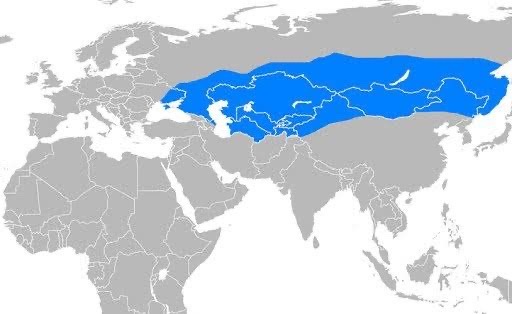
Only Mongol Empire would manage to be bigger than Göktürk Empire (above) and I think Mongolia took inspo from the dude directly (and beyond, ofc). Mongolia rose from one of the lesser powers of Mongolian steppe during the time, and took over the ‘land of kings’ of Orkhon valley, previously dominated by the Kerait, then before that the Uyghurs, then the Göktürk, then the Xiongnu. He made it into his own and built Karakorum in it.
#hetalia#aph mongolia#my favest mongolia ships: with the turks ahah#he was surrounded by the turks and is still p much surrounded by them and other nomads#children of the wolves
4 notes
·
View notes
Text
Currently reading about the Oirats. Consulting a research article~
The question I’m asking myself is whether Kalmykia would be an *actual* grandchild of Mongolia or would they just be a grandchild of a sibling? (a relative)? This distinction is important.
Key notes of the article:
During early Mongol Empire era, historical Oirats were not classified as Mongol but similar to the Keraites and Naimans (in their non-Mongolness). This is recorded in the Secret History of the Mongols and the historical texts by Rashid al-Din. They then submitted to Mongol Empire just like other non-Mongols around the area did.
(Personal note: today, Keraites and Naimans for ex would be grouped into Turkic ppls (like Kazakh) or Mongol, as these names were historically confederate names)
Oirats might’ve submitted to the Chinggisids, but during Northern Yuan era they then challenged Chinggisid authority and formed their own confederate, Four Oirat. This confederate mainly consisted of groups historically regarded as non-Mongols (of Chinggisid Ulus).
Kalmyks have different Y-DNA haplogroup compared to modern Mongolians. Modern Mongols display 34.78% of ‘star cluster’ (C2 type) or Chinggisid lineage in their Y-DNA. Kalmyks only have 1.67%.
Oirats however were historically regarded as belonging to the larger Mongol (of Northern Yuan = Chinggisid) group by Manchu Qing and Ming. Some Central Asian writers also tend to group Oirats as the same as larger Mongol group under the term Qalmaq. However this term basically only means Tatars and Turkics, basically nomads in Central Asia, who didn’t convert to Islam, while the Muslim converts were newly called Uzbeks. Qalmaq means ‘those who remained behind’.
Chinggisid and Timurid Central Asian writers differentiated between Oirats and Mongols tho. Also, they identified themselves with the Mongols which they never did with Oirats.
Northern Yuan Mongols also differentiated themselves from the Oirats whom they constantly had feuds with. Meanwhile, they regarded Turkicized Chinggisids as kins.
Oirat writers in their works described of themselves as Mongolic people but not of Northern Yuan Mongol stock. A Kalmyk Khan once told Russians and Ottomans that Oirats were also Chinggisid tho.
Now for consistency in my headcanons:
My Mongolia is not a personification of *all* Mongols, but only for Borjigid-Chinggisid Mongol affiliated political entity (obviously today’s Mongolia is no longer ruled by that stock, but this stock did mark the formal start of Mongolia’s existence). Therefore, Kalmykia is a kin but not Mongolia’s own descendant. Next on I’ll be researching Buryatia and Tuva, hha.
6 notes
·
View notes